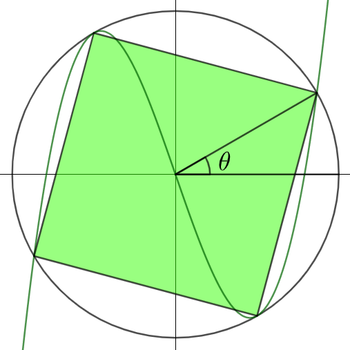-Chebyshev Magic

In the rectangular plane, the graph uniquely presented by the cubic polynomial function passes through the square inscribed in a unit circle centered at the origin. There exists the rotation angle of the vertex about the origin, such that the cubic equation passes through the circle exactly at vertices.
If can be expressed as radians, where are coprime positive integers and , input the product as your answer.
The answer is 6.
This section requires Javascript.
You are seeing this because something didn't load right. We suggest you, (a) try
refreshing the page, (b) enabling javascript if it is disabled on your browser and,
finally, (c)
loading the
non-javascript version of this page
. We're sorry about the hassle.
By symmetry, the cubic must be odd. Then the cubic y = a x 3 + b x passes through the points ( ± cos θ , ± sin θ ) and ( ± sin θ , ∓ cos θ ) , and the gradient of the cubic at the latter two points is tan θ . Thus a cos 3 θ + b cos θ = sin θ a sin 3 θ + b sin θ = − cos θ 3 a sin 2 θ + b = tan θ Thus we deduce that a = sin θ cos θ ( cos 2 θ − sin 2 θ ) 1 b = − sin θ cos θ ( cos 2 θ − sin 2 θ ) cos 4 θ + sin 4 θ and hence sin θ cos θ ( cos 2 θ − sin 2 θ ) 3 sin 2 θ − sin θ cos θ ( cos 2 θ − sin 2 θ ) cos 4 θ + sin 4 θ 3 sin 2 θ − cos 4 θ − sin 4 θ 3 tan 2 θ ( 1 + tan 2 θ ) − 1 − tan 4 θ 3 tan 4 θ + 2 tan 2 θ − 1 ( 3 tan 2 θ − 1 ) ( tan 2 θ + 1 ) = tan θ = sin 2 θ ( cos 2 θ − sin 2 θ ) = tan 2 θ ( 1 − tan 2 θ ) = 0 = 0 so that tan θ = 3 1 , and hence θ = 6 1 π , making the answer 1 × 6 = 6 .